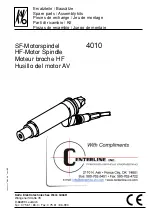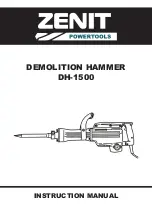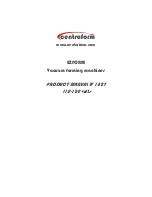
23
If any part is missing, bent, or broken
in any way, or any electrical parts
don’t work properly, turn the sander
off and unplug the sander. Replace
damaged, missing, or failed parts
before using the sander again.
Disconnect the sander to reduce
the risk of injury from accidental start-
ing. Turn switch off, unplug sander
and remove the switch key before
changing the setup or sanding drum.
Maintain tools with care. Keep the
sander clean for maximum and safest
performance.
To reduce the risk of injury from
jams, slips or thrown pieces:
• Use only recommended accesso-
ries.
• Use the correct spacer ring
insert. The opening between the
sanding sleeve and insert must be
5/32 of an inch or less. (See page
15)
• All sanding drums, washers and
knobs are tight. No parts should
have excessive play prior to operat-
ing unit.
• Keep work area clean. Cluttered
work surfaces invite accidents. Floor
must be clean and dry for stable
footing.
Plan Ahead To Protect Your Eyes, Hands, Face and Ears
Dress for Safety
• Any power sander can throw foreign
objects into the eyes. This can result
in permanent eye damage. Always
wear safety goggles, not glasses
complying with ANSI Z87.1 (or in
Canada CSA Z94.3-99) shown on
package. Everyday eyeglasses
have only impact resistant lenses.
They are not safety glasses. Safety
goggles are available at many local
retail stores. Glasses or goggles not
in compliance with ANSI or CSA
could seriously hurt you when they
break.
• For dusty operations, wear a dust
mask along with safety goggles.
• Wear nonslip footwear.
• Tie back long hair.
• Roll long sleeves above the elbow.
• Noise levels vary widely. To reduce
the risk of possible hearing damage,
wear ear plugs or muffs when using
sander for hours at a time.
• Sanding operations are usually
dusty. Wear a dust mask along with
the safety goggles.
• Do not wear loose clothing, gloves,
neckties or jewelry (rings, wrist
watches). They can get caught and
draw you into moving parts.
Know your sander. Read and under-
stand the owner’s manual and labels
affixed to the tool. Learn its applica-
tion and limitations as well as the spe-
cific potential hazards.
Plan your work. Think through how
you will hold and maneuver the work-
piece against the sanding drum or
belt.
Use the right tool. Don’t force tool or
attachment to do a job it was not
designed to do.
To reduce the risk of injury from
accidental contact with moving
parts:
• Do not layout, assemble, or setup
work on the sander while any parts
are moving.
• Reduce the risk of accidental
starting. Make sure switch is “OFF”
before plugging sander into a power
outlet.
Summary of Contents for EB4424
Page 1: ...OSCILLATING EDGE BELT SPINDLE SANDER ...
Page 35: ...35 Notes ...














































